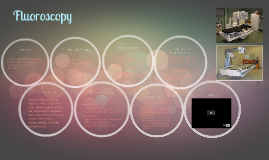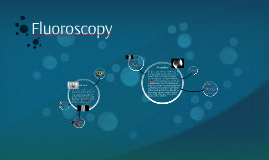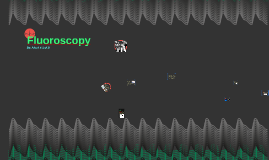Fluoroscopy
Transcript: Fluoroscopy can be used in many examinations and procedures, such as barium X-rays, cardiac catheterization, placement of intravenous (IV) catheters , intravenous pyelogram, hysterosalpingogram, and biopsies. Fluoroscopy is an important tool for pacemaker surgery. It is also used in placement of eating tubes, without this, it would have failed. Fluoroscopy can be used as a diagnostic procedure, can also be used in conjunction with other diagnostic or therapeutic media or procedures. Fluoroscopy is used to assist doctors to see blood flow through the coronary arteries, so as to assess what causes arterial occlusion. Fluoroscopy assists the doctor in guiding the catheter into a specific location. Fluoroscopy is used in barium enemas, swallowing and meals, in defecating proctograms and enteroclysis. Fluoroscopy is also used in orthopedic surgery. Angiography of the leg, blood vessels and heart uses fluoroscopy, Cons Uses in the medical field Fluoroscopy Webdesign, C. (n.d.). Fluoroscopy. Retrieved October 09, 2017, from http://www.rasloimaging.com/features/fluoroscopy/ Fluoroscopy. (n.d.). Retrieved October 09, 2017, from http://veterinaryspecialtycare.com/diagnostic/fluoroscopy/ Fluoroscopy. (n.d.). Retrieved October 09, 2017, from http://www.cradiology.com/examinations/fluoroscopy.html G. (n.d.). Fluoroscopy GIFs - Find & Share on GIPHY. Retrieved October 09, 2017, from https://giphy.com/search/fluoroscopy Azad, A. (2013, May 13). X- ray Fluoroscopy. Retrieved October 03, 2017, from https://prezi.com/hy-0cgvcjkmf/x-ray-fluoroscopy/ Fluoroscopy. (n.d.). Retrieved October 05, 2017, from https://image.baidu.com/search/detail?ct=503316480&z=0&ipn=d&word=Fluoroscopy&step_word=&hs=0&pn=114&spn=0&di=46898544770&pi=0&rn=1&tn=baiduimagedetail&is=0%2C0&istype=0&ie=utf-8&oe=utf-8&in=&cl=2&lm=-1&st=undefined&cs=485724845%2C921078168&os=1587209073%2C1684835874&simid=3374906905%2C210215764&adpicid=0&lpn=0&ln=232&fr=&fmq=1507221665916_R&fm=&ic=undefined&s=undefined&se=&sme=&tab=0&width=undefined&height=undefined&face=undefined&ist=&jit=&cg=&bdtype=0&oriquery=&objurl=http%3A%2F%2Fwww.biomedsearch.com%2Fattachments%2F00%2F22%2F45%2F30%2F22453050%2F1532-429X-14-21-2.jpg&fromurl=ippr_z2C%24qAzdH3FAzdH3Fooo_z%26e3Bkt54j1fjw6vi_z%26e3Bv54AzdH3FgtiAzdH3FT5ow61f-6jws-pt4j-vw61t5ewfv7sw6-4w2gjptvAzdH3Fdd9cnaca_z%26e3Bip4s&gsm=3c&rpstart=0&rpnum What is a Fluoroscopy and Why Might You Need It? (n.d.). Retrieved October 03, 2017, from http://www.hopkinsmedicine.org/healthlibrary/test_procedures/orthopaedic/fluoroscopy_procedure_92,P07662 Center for Devices and Radiological Health. “Medical X-Ray Imaging - Fluoroscopy.” U S Food and Drug Administration Home Page, Center for Devices and Radiological Health, 2 Mar. 2017, www.fda.gov/radiation-emittingproducts/radiationemittingproductsandprocedures/medicalimaging/medicalx-rays/ucm115354.htm. Accessed 3 Oct. 2017. What is it - Fluoroscopy can result in high radiation doses, especially for complex interventional procedures. - Radiation- injuries to the skin and underlying tissues like “burns”, which will occur in a very short period after the exposure. - Radiation-induced cancers, which may occur in a long period (sometime later in life). - Soft tissue resolution is very poor. If you are pregnant, You need to notify your doctor before scheduling the exam. For other options, you may discuss with yout doctor You will be provided with a patient gown, and may asked to wear it. You will be provided a locker to place your personal belongings. You need to remove all jewelry and valuables, it's best to leave them at home. You must drink lots of fluid. You can drink only black coffee, plain tea, clear fruit juice or water . You cannot eat cream and milk. Low residue foods are best for you - Such as white bread, cream of wheat, meat (no fried food!), chicken, ham, and all defined liquids are allowed. You need to avoid raw fruits, raw vegetables, nuts, raisins, whole-wheat products, cold cuts, cheeses, hotdogs, and meat fats. If you are allergic or sensitive to medication, you need to notify the radiologist or technologist. How it works How a patient is prepared Pros Procedure sources A fluoroscope allows a physician to observe the internal structure and function of a patient. It is a study of moving body structures. It is a type of imaging technology which uses x-rays to provide detailed information in real time. It shows a continuous X-ray image on a monitor, It's just like an X-ray movie. X-ray beam is passed through the body part being examined. Fluoroscopy procedures are used to help diagnose disease, or to guide physicians in the treatment procedures. Fluoroscopy 's best used is to examine how things move through the patients' body. It is used for blood flow studies Fluoroscopy is used in many types of examinations and procedures to treat or diagnosis patients. For example : -Barium X-rays and enemas • It is not a painful procedure • There is valuable informationcan be find from this technology

















